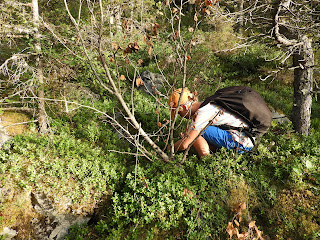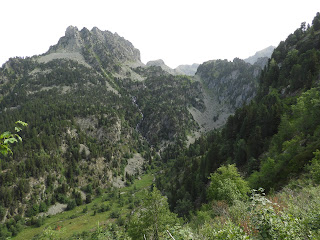Grenoble is a gorgeous city with spectacular views. The city is surrounded by mountains and the buildings are historic and provide a nice character. The streets are lined with shops and cafes expected in France.
 |
| Grenoble, France |
Two rivers (Isere and Le Drac) run through the city creating nice scenic walks beside the channel and over stone bridges.
 |
| Grenoble, France |
The museum d'historie naturelle jardin de plants (botanical garden) was quite small and lacked any significant numbers of wildlife, but the flowers were out in full bloom with the mountain winds bringing the smell of roses to your nose.
 |
| jardin des plantes, musedum d'histoire naturelle, Grenoble, France |
A man-made pond housed some turtles including one North American species, a red-eared slider, native to the U.S.
 |
| Turtles at musedum d'histoire naturelle, Grenoble, France |
With such warm weather I am sure the turtles were loving their lives basking in the sun but we went searching for a place to stay in the shade for a while.
 |
| Relaxing in the shade |
I convinced William to go camping in the mountains near Grenoble between visiting friends but sadly we only had one night to spare for it since we were cramming so much into two weeks. I was still ecstatic and we picked a hike up to a La Cascade de l'Oursiere and Lacs Robert.
The trail was a bit rough around the edges in some places and it was quite steep in others but it was never a problem and the hike was very enjoyable and beautiful.
 |
| Trail to Lacs Robert |
A few small waterfalls were a bit of a tease on our way up to the main event and kept making us think we had arrived in great time.
 |
| Trail to Lacs Robert |
This one was my absolute favorite with so many ferns and lovely plants making it look so lush and green. The mountain peaks in the background also don't hurt the scenery.
 |
| Gorgeous small falls along the trail to Lac Robert |
The views got better and better as you climbed and the forested areas shrunk. Literally the trees became shorter and shorter with higher elevation and the city grew smaller in the distance.
 |
| Trail to Lac Robert |
 |
| View of the city getting further and further below us |
We made it to the La Cascade de l'Oursiere before sunset and decided to climb to the top of it before camping for the night. We had planned to hike all the way to the top of the mountain and camp here on our way down. Guess we had been a bit slower than expected.
 |
| La Cascade de l'Oursiere |
 |
| La Cascade de l'Oursiere |
Despite not making it to the absolute top of the mountain as we had planned I was absolutely stunned and thrilled to be sleeping on top of the waterfall. We had stopped in an alpine meadow above the falls for sunset. Although this didn't have
the full views of the landscape that we would have had at the top, we
had a gorgeous meadow of wildflowers, a firepit already set up and some
privacy in the short trees of the creek valley.
 |
| River on way to Lacs Robert |
 |
| River meadow on way to Lacs Robert |
For dinner we had a typical French picnic of sausisson, bread, cheese
and of course wine to go with it all. The night was clear with bright
shooting stars in the sky.
I was instantly in love with the meadow and despite the darkness I still took photos that night. Flora in the French Alps looks strikingly similar yet strikingly
different to what I am familiar with. I don't know for sure exactly what
all of these are since I don't have any field guides for the area but here are
some guesses. This website also has a few alpine plants identified but not a lot of what I saw: https://frenchmoments.eu/flora-of-the-french-alps/
 |
| Perennial Coneflower- Centauree des montagnes - Centaurea montana |
 |
| Perennial Coneflower- Centauree des montagnes - Centaurea montana |
Digitalis lutea is a very tall striking plant that is hard to miss on the hike we were on since it was in frequent patches in along some of the creek valley meadows. There was also Greater Yellow Gentian (
Gentian lutea), but this wasn't blooming at the time I visited.
 |
| Digitalis lutea |
Gentians are also quite distinct and look similar in most places
around the world. Unfortunately that doesn't help me figure out what
species this one is. It was growing very low to the ground but only had one stalk. It was found quite high in elevation above the creek meadow.
 |
| Some species of alpine Gentian |
Helleborine orchid is a species that is recently introduced to Canada but is one of the only species that might have actually been introduced naturally since it's spore can be carried on the wind currents. Finding this was a treat because it was recognizable.
 |
| Epipactis helleborine |
I really don't know what this is and I apparently didn't take very good photos to figure it out later. But it was quite pretty and scattered throughout the meadow. If you recognize it please leave a comment!
Many times I wish I had taken more photos or gotten a better look at the plants characteristics since I don't have much to identify based on and this was my first visit to the French Alps so I am really not familiar with what they have there.
 |
| Scrophulaceae or Laminaceae |
 |
| Scroph sp.? |
 |
| Allium sp. |
Higher up there were some gorgeous views. Less vegetation was growing but the rocks occasionally had thick mats of low growing vegetation. There were also sooooooo many blueberries and it was in season!
 |
| Blueberry picking in the French Alps |
In the morning we decided to finish our hike off with a trip up to Lacs Robert. On the hike up I was amazed to find a lizard crawling around on a dead tree. I was so excited to find it I would have been jumping up and down if I hadn't been quite vertical on the trail at the time.
 |
| Lizard in the French Alps |
 |
| View down into the meadow |
We hiked up to another plateau in the mountain where there was less
trees and meadow but the vegetation was growing in low shrubs or thick
low mats. It was incredibly different than it had been lower down by the
stream.
 |
| Allium sp. growing on trail above the plateau |
 |
| View on trail to Lacs Roberts |
 |
| View on trail to Lacs Roberts |
Despite the spectacular views it was a bit challenging to spot birds. There was so much open space with very few scattered tree and the birds were very well camouflaged or very far away. The large number of people on the trails didn't help much either.
 |
| View on trail to Lacs Roberts |
I feel like I could have sat in one spot all day and just watched
everything. I did manage to see a few species well enough to ID,
including:
Sombre Tit
Black Redstart
Mistle Thrush
Linnet
 |
| Black Redstart |
 |
| Mistle Thrush juvenile (left) being fed by adult (right) |
Closer to Lac Robert the vegetation changed again with only sparse low growing vegetation.
 |
| Mountain Houseleek - joubarbe des montagnes- Sempervivum montanum |
This white flower had a flower much larger than the small sprig of a plant that it came from.
Lacs Robert was bustling compared to the empty secluded lake I was expecting and we decided not to swim there but jumped in the very shallow cold waters of the stream above the falls on our way down. It was very chilly but with the hot weather it refreshed us for the hike down. Not to mention cleaned off a bit of the hiking smell.
 |
| First view of Lacs Robert |
I wish I had longer in this stunning area and would definitely go back in a heartbeat. Or more likely the millions it took to hike up there but you get my meaning. A tough hike but very worth it even for the brief visit. If someone started very early in the day they might even be able to make it up and down before dark but I don't think I would enjoy rushing it as much as taking the time to enjoy it.



















































